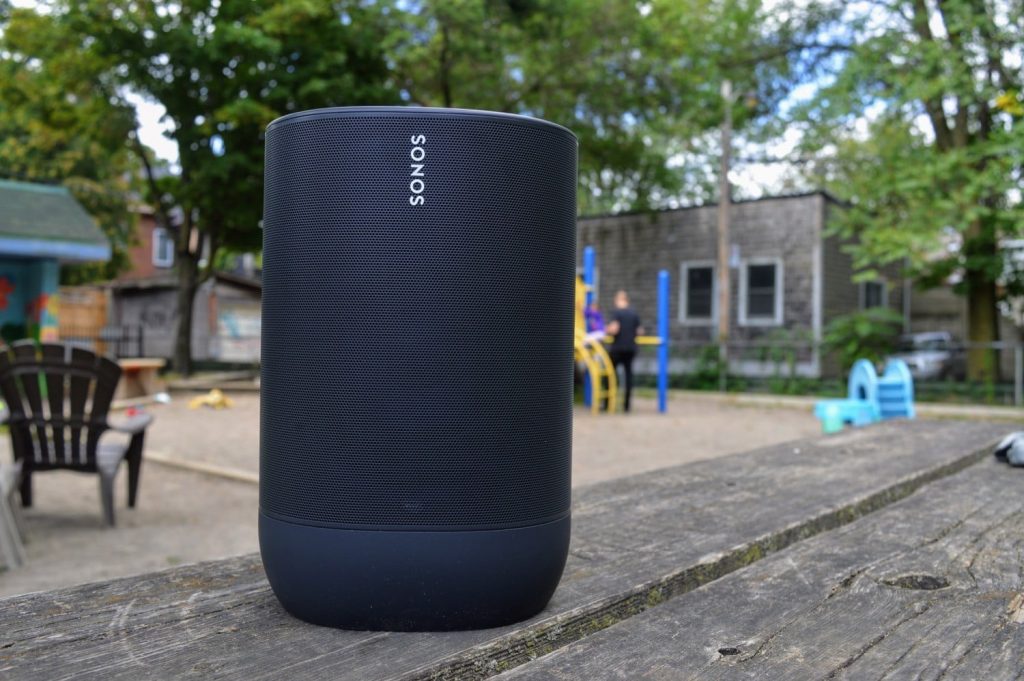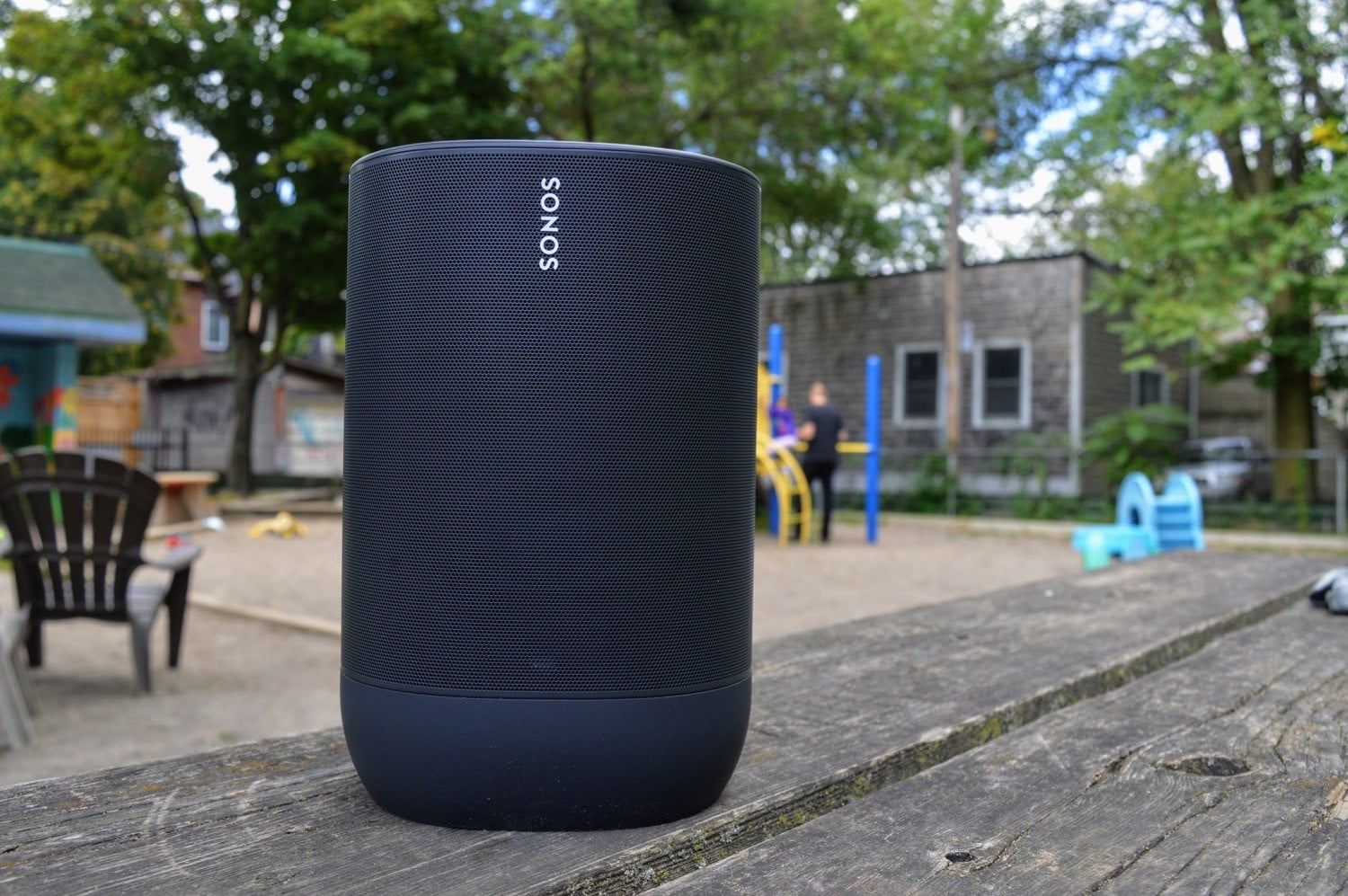Sonos Move Review: It Delivers What it Promises

Sonos Move Review: Image Source
Sonos speakers are good, but you can hear them inside. It has the desired sound but the built-in battery made Move, the first portable Sonos device among competitors. Amazon Alexa and Google Assistant are also available in it, making this a helpful voice control in smart households.
Sonos Move is equipped with a new Auto TruePlay technology, which uses a mic to adapt the speaker to the setting automatically. It is a wonderful portable variant of the popular Sonos One, with a 10-hour bluetooth command, battery life. But this speaker has a bonus.
Design
This is very similar to the previous Sonos model. They are black speakers with metal front grille, with capacitive buttons to control the top of the playback and four remote field microphones. At the rear there is an on/off switch, a Bluetooth/ Wi-Fi on & off switch and a multi-space installation switch.
Sonos Move uses two Class D digital amplifiers, high frequency tweeters for high frequencies and midrange for low frequencies, which are integrated in the midrange and in the bass cabinet. Sonos has built a case that is resonant and balanced in every way – the outside world knows no bounds.
As a portable product, it has been extensively tested for durability. Sonos also argues to resist severe cold and heat. Whether your party is in the desert or in a snowstorm, Mono Sonos must protect you. It has a protection level of IP56, which means it is resistant to sand or dust as well as a drop in the pool. There is even a trough in the cage to drain the water, while Sonos claims that during the fall test, chunks of concrete broke before the loudspeakers went down.
That will be the weight, we imagine. Standing 240 x 160 x 126 mm, easy to carry but not small. Weighing almost 3 kg, you can easily lift Sonos Move, but don’t want to wear it for too long. This is needed by the big magnet drivers here and it is a fair trade to deliver the quality of the sound delivered. To facilitate loading, this case has a recess in the handle on the back to make it a little easier.
Battery Life
Based on our tests, the battery life is good for the specified 10 hours and was fully charged in about 2.5 hours. You can charge the Sonos Move via USB-C, but you may use the primary dock that charges the speaker whenever you sleep or take rest. Sonos Move also uses standby mode to save energy when it detects that the device has not been used for about 30 minutes. This can save energy for up to 5 days without having to recharge the device.
Sonos estimates that the average battery reduction will occur after around 900 charging cycles or around three years of daily use. You can use spare battery after the original battery has been dead. So, you don’t need to throw away your Sonos Move speaker anyway.
Smart Features
Sono has a strong reputation in manufacturing wireless speakers. Just because this is its first attempt to be portable doesn’t mean one of these influences is lost. Moving, like other Sonos speakers, these can be used as a stereo pair or as part of a multi-room group. If you want to play a song in your garden the same song that is played at Sonos Move elsewhere in your house, you can do it without losing a beat.
Sonos Move works with all connected audio sources stored online or on the local network. If you want to activate playlists on Spotify with Spotify Connect, the application makes it as easy as playing the things you download to a network storage device. All your sources will be displayed via Wi-Fi after starting the Sonos application, but don’t forget to set up and connect to the Internet.
Go beyond Wi-Fi and turn on Bluetooth again. It doesn’t come with 5.0 connectivity Version rather it has 4.0 connected system. But Sonos said its Bluetooth 4.2 experience allowed it to reach greater volume, range, and power saving than before. Although the company did not specify a range for Bluetooth or Wi-Fi, it only said, “If you hear it, you can control it.” Four Wi-Fi antennas are located at the bottom of Move. To guarantee the finest coverage, the Bluetooth unit is placed at the top. For Apple phones, AirPlay 2 is also endorsed.
The microphone unit mounted above serves two purposes. First, you will get access to the Google Assistant language assistant chosen by Amazon Assist. All AI Assistants are fully compatible with Sonos Move. It allows you to use the necessary features like access calendars, act as voice juke boxes, and controlling pet smart devices.
Microphone and Smart Assistant connectivity works very well here. Even in the chat room and with speakers singing The National, we can accept our requests – even if the answers are not always exactly what we wanted. But it’s up to Amazon and AI Google employees, not engineers at Sonos.
Next, the Trueplayer Audio Optimization System is a central part of this microphone. They analyze the Sonos Move output and how the environment influences it and automatically adjust it to the intended studio sound. What’s really smart is that it knows when Sonos’s movements get lost – there is a built-in accelerometer that triggers the TruePlay setting when it detects movement.
Final Verdict
Nearly the only thing that Move does not support is its use as part of the 5.1 home theater rear channel, as it can with several other Sonos devices. According to Sonos, it is caused by synchronization problems and risk problems so that the directed soundtrack loses focus when a speaker can be placed in a room. However, it is unfortunate that wireless surround sound can be produced here. It costs only $399.
Read Next: Huawei unveils FreeBuds 3, alike Apple’s AirPods with round charging case




